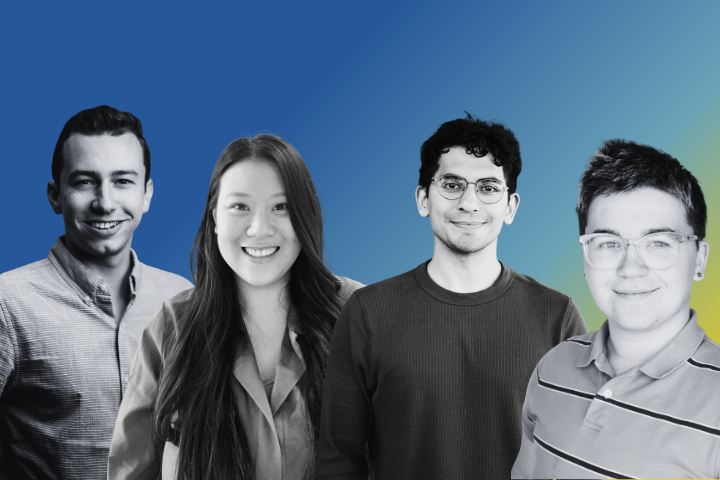New cohort of UCI-LANL-SoCal Hub fellows advancing their fields at top national laboratory

The new fellows, from left to right: Julian Arnheim, Jayme Chow, Cesar Gallegos and Izzie Catanzaro
The UCI-LANL-SoCal Hub graduate fellowship program, now in its third year, named four fellows for the 2024-2025 cohort.
The fellowship gives UC Irvine graduate students the opportunity to work directly with leading scientists at Los Alamos National Laboratory. Since the program was established, nine students in the School of Physical Sciences have participated, immersing themselves in high-impact research projects alongside their UC Irvine faculty advisors and LANL mentors. Each fellow receives one year of funding to support their research with LANL.
“Our ongoing partnership with LANL to provide graduate students with an opportunity to deepen ties between UC faculty and Laboratory Scientists is one of our best initiatives within the School,” said Professor Franklin Dollar, associate dean of graduate studies at the UC Irvine School of Physical Sciences. “This year’s fellows are at the forefront of cutting edge science, leveraging strengths of both institutions which will serve them well on their career paths.”
Each fellow’s research and collaboration with LANL highlight the opportunities fostered by the program. Below are some pioneering research endeavors that have resulted from the partnership between UC Irvine and Los Alamos National Laboratory.
2024-2025 UCI-LANL-SoCal Hub graduate fellows
Julian Arnheim, Earth System Science
UC Irvine Advisor: Gudrun Magnusdottir
LANL Mentor: Wilbert Weijer
Julian Arnheim, a Ph.D. student working with Professor Gudrun Magnusdottir in the UC Irvine Department of Earth System Science, uses models to study the polar jet stream: the fast, narrow, undulating ribbon of winds about 10 to 15 kilometers above the Earth’s surface that steer weather systems across the mid-latitudes. “With this fellowship, I’m applying established methods to assess the strength and behavior of the jet stream to the U.S. Department of Energy’s Energy Exascale Earth System Model (E3SM), including a new version that simulates the Arctic at higher resolution,” said Arnheim. “I’m particularly interested in the North Atlantic, a region where many climate models project a patch of cooling off the southern coast of Greenland even as nearly all the world’s oceans warm.”
Jayme Chow, Chemistry
UC Irvine Advisor: Stacy Copp
LANL Mentor: John Watt
Jayme Chow, a Ph.D. candidate in the lab of Professor Stacy Copp in the UC Irvine Department of Chemistry, is studying the material properties of gold nanoparticles. “With the fellowship, working with Dr. John Watt at CINT (Center for Integrated Nanotechnologies), I’m going to be able to characterize and analyze my samples with state-of-the-art equipment at LANL that I do not have access to here at UCI.” The fellowship will augment Chow’s efforts to develop a method to optimize the ways nanomaterials are currently made. “With our system based on general chemical interactions, our method is much more generalizable and universal to different nanoparticle types,” said Chow. “With a more universal approach, this could open the gate to accessing novel materials with unique optical properties that can be used in a multitude of applications.”
Cesar Gallegos, Physics & Astronomy
UC Irvine Advisor: Alexander (Sasha) Chernyshev
LANL Mentor: Shi-Zeng Lin
UC Irvine Department of Physics & Astronomy Ph.D. student Cesar Gallegos’ quantum science research stands to completely change how we develop new technologies. That’s because Gallegos is on the hunt for quantum materials that could lead to devices that do not require electricity to hold a charge. “Modern electronic devices face a fundamental limitation, as the flow of charge inevitably generates heat due to intrinsic resistance in real materials, resulting in energy loss,” said Gallegos, who’s a first-generation Ph.D. student. “To overcome this challenge, we can turn to another quantum-mechanical property of electrons: their magnetic moment, or spin. Exploiting the spin rather than the charge opens new pathways for the development of ‘quantum magnets,’ materials whose collective excitations can transport energy with minimal dissipation.”
Izzie Catanzaro, Physics & Astronomy
UC Irvine Advisor: Luis Jauregui
LANL Mentor: Priscila Rosa
Izzie Catanzaro is a Ph.D. student in the lab of Professor Luis Jauregui in the UC Irvine Department of Chemistry. Catanzaro studies how acoustic waves travel via electric currents in a two-dimensional quantum material called graphene, which can function as a superconductor. “I was awarded the So-Cal LANL fellowship to work with Dr. Priscila Rosa doing electronic transport of a 2-D unconventional superconductor called uranium teleride,” said Catanzaro. “The 3-D crystal form of this compound exhibits superconductivity that’s dependent on the pressure of the surrounding system, something that allows us to study it using acoustic waves.”
